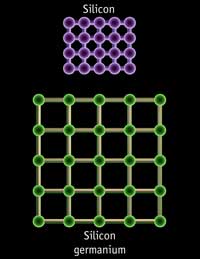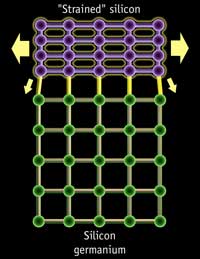Intel's Pentium 4 E: Prescott Arrives with Luggage
by Anand Lal Shimpi & Derek Wilson on February 1, 2004 3:06 PM EST- Posted in
- CPUs
Something to be proud about
Intel is particularly proud of their 90nm process as it incorporates new technologies that are a first in desktop microprocessors. The biggest of them all is the use of Strained Silicon, which we explained back in August of 2002 when Intel first announced that they would use the technology:
Strained Silicon works by effectively stretching the silicon in the channel region of the transistor. The engineers at Intel's fab facilities don't sit there and pull on both ends of the silicon in order to get it to stretch; rather they place the silicon on top of a substrate whose atoms are already spaced further apart than the silicon that needs to be stretched. The result of this is that the silicon atoms on top of the substrate will stretch to match the spacing of the substrate below, thus "stretching" the silicon in the channel.
 |
 |
|
Silicon is "strained" by using a substrate of more widely spaced atoms below the silicon channel of a transistor. (Images courtesy of IBM) |
|
With more well spaced silicon atoms, electrons can now flow with less resistance in the channel meaning that more current can flow through the channel when needed. The end result is a 10 - 20% increase in drive current, or the current flowing through the channel of the transistor.
![]()
Intel claims that their Strained Silicon technology has no real downsides (unlike competing solutions) other than its 2% increase in manufacturing costs. Intel's 90nm process will make use of Strained Silicon technology to improve the performance of their 90nm transistors.
Intel’s 90nm process does not make use of Silicon on Insulator and according to their manufacturing roadmaps it never will. Intel will introduce SOI on their 65nm process in 2005.

Prescott's 112 mm^2 die
Prescott is Intel’s first desktop microprocessor to have 7 metal layers, 2 fewer layers than AMD’s Athlon 64. Intel had to add the 7th layer simply because of the skyrocketing transistor count of Prescott (125 million vs. Northwood’s 55 million). It’s not normally desirable to increase the number of metal layers you have on a chip as it increases manufacturing complexity and cost, but in some cases it is unavoidable. The fact that Intel was able to keep the number of metal layers down to 7 is quite impressive, as AMD had to resort to 9 layers dating back to the introduction of their Thoroughbred-B Athlon XP core to keep clock speeds high.
|
CPU Core Comparison |
|||||
| Code Name |
Willamette |
Northwood |
Northwood EE |
Prescott |
AMD Athlon 64 |
| Manufacturing Process |
0.18-micron |
0.13-micron |
0.13-micron |
90 nm |
0.13-micron |
| Die Size |
217 mm^2 |
131 mm^2 |
237 mm^2 |
112 mm^2 |
193 mm^2 |
| Metal Layers |
6 |
6 |
6 |
7 |
9 |
| Transistor Count |
42 Million |
55 Million |
178 Million |
125 Million |
105.9 Million |
| Voltage |
1.750V |
1.50V |
1.50V |
1.385V |
1.50V |
| Clock Speeds |
1.3 - 2.0GHz |
1.6 - 3.4GHz |
3.2 - 3.4GHz |
2.8 - 4GHz+ |
2.0GHz+ |
| L1 Instruction/Trace Cache | 12K µops |
12K µops |
12K µops |
12K µops |
64KB |
| L1 Data Cache | 8KB |
8KB |
8KB |
16KB |
64KB |
| L2 Cache | 256KB |
512KB |
512KB |
1MB |
1MB |
| L3 Cache | N/A |
N/A |
2MB |
N/A |
N/A |










104 Comments
View All Comments
sprockkets - Monday, February 2, 2004 - link
Hmmm... on Intel's website on the new processor news: "Thermal Monitoring: Allows motherboards to be cost-effectively designed to expected application power usages rather than theoretical maximums."Not sure what it means. I'm thinking clock throttling so that if your particular chip is hotter than it should be it will run on under engineered motherboards/coolers.
This chip dissipates around the same heat as Northwoods clock for clock! And of course, Intel style is wait 6-12, then the new stuff will actually be good. Still, is it really that important to increase performance so much that heat becomes an issue? I.E., will Dell be able to make the cooling whisper quiet? They can with the processor sitting at 80-90c, but now that with normal cooling it's almost there, now what will they do? Why can't we just have new processors that run so cool that we can just use heatsinks without fans? Oh well.
Novaoblivion - Monday, February 2, 2004 - link
Great article :) I found it very interesting I dont think I'll be buying a prescott till they hit about 4Ghz. My 2.4C is nice and fast for now.CRAMITPAL - Monday, February 2, 2004 - link
http://www.theinquirer.net/?article=13927
http://www.theinquirer.net/?article=13947
johnsonx - Monday, February 2, 2004 - link
To Vanners, #38:"if you halve the time for a stage in the pipeline and double the number of stages. Yes this means you can run at 2GHz instead of 1GHz but the reality is you're still taking 5ns to complete the pipe."
Yes and no... In the example, you're right that a single instruction takes the same 5ns to complete. But you're not just executing a single instruction... rather, thousands to millions! The 10 stage pipe has twice as many instructions in flight as the 5 stage pipe. Therefore in the example, you get one result out of the 5-stage/1Ghz cpu every 1ns, but TWO results out of the 10-stage/2Ghz cpu in the same 1ns... twice as many.
What I find interesting is that as pipelines get longer and longer, we might have to start talking about Instruction Latency: the number of clocks and ns between the time an instruction goes in and when the result comes out. It'll never be anything a human could notice directly, but it might come into play in high-performance realtime apps that deal with input from the outside world, and have to produce synchronized output. Any CPU calculates somewhat "back-in-time" as instructions fly down the pipe... right now, a Prescott calculates about twice as far behind 'reality' as an A64 does. I don't know if there is any realworld application where this really could make a difference, or if there ever will be, but it's interesting to ponder, particularly if the pipeline lengths of Intel vs. AMD continue to diverge.
cliffa3 - Monday, February 2, 2004 - link
i don't see how a 4+GHz prescott will match up with intel's new pico BTX form factor...with that much heat (using air cooling), you need to keep a safe zone around the proc unless you like your RAM DDR+BBQ.I'd have to say that a lot of enthusiasts are younger and live in limited space conditions...might work well for people up north who don't want to run the heater, but as for me in texas, i have all the cool air pumping in to my bedroom and it still takes a lot to keep it cool. Can you imagine a university or corporation having a room full of those?..if they think about that, then it's no bueno for DELL and others as well.
I'd also have to agree with the others about the heat/power being a major part of the article that was left out...otherwise a tremendous read, thanks for all the effort that goes into these.
tfranzese - Monday, February 2, 2004 - link
But - I need to add - the correction was needed and is welcome. Not trying to pick a bone with the editors.tfranzese - Monday, February 2, 2004 - link
#55, you read what I read. I'll vouch for you.Icewind - Monday, February 2, 2004 - link
#55Better go back to sleep me thinks :)
Spearhawk - Monday, February 2, 2004 - link
Is it just me (who was extremely tired yesterday) or has the 101 on pipeline part changed since the article was put up?I seem to rememeber reading someting about how a 5 staged CPU at 1 Ghz should be exactly as fast as a 2 GHz CPU with 10 stages (all else being equal of course) and that the secret of geting any profit out of going to more stages was to make sure that it couldn't only scale to 2 Ghz but to 3 Ghz or more.
Icewind - Monday, February 2, 2004 - link
I think shuttle owners are SOL with prescott.